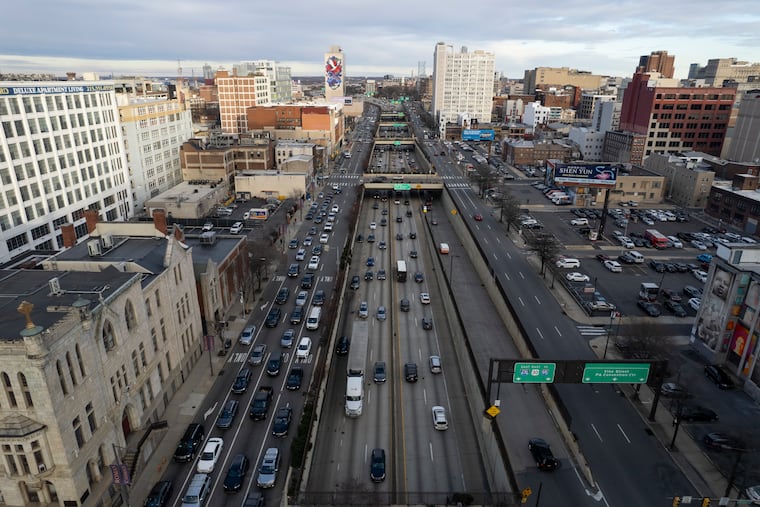A big step forward for the Chinatown Stitch as $158 million is awarded to cap the Vine Expressway
"The Stitch" will include a public park across the expressway, traffic calming measures, and a connection to the Rail Park on the Reading viaduct.

The effort to build the Chinatown Stitch, which aims to reconnect a severed neighborhood by capping part of the Vine Street Expressway, took a giant leap forward on Monday with the award of a $158 million federal grant.
Officials said they anticipate a 2027 groundbreaking for a project that would cover part of the below-ground-level expressway and tie Chinatown proper to the area known as Chinatown North.
“This is transformative,” said John Chin, executive director of the Philadelphia Chinatown Development Corp., after the Monday announcement in Chinatown.
He joined government officials including Mayor Cherelle L. Parker and U.S. Reps. Dwight Evans and Brendon Boyle, all Democrats.
“We’re finally on the path to reconnecting Chinatown,” U.S. Sen. Bob Casey (D., Pa.) said at the news conference.
Officials said the funding represents money to build the cap, which would reach from 10th to 13th Streets, not for more study of the issue. The new funding will include development of a public park across the expressway, traffic calming measures, and a connection to the Rail Park on the Reading viaduct.
The form of any structures to go on the cap is yet to be determined but could include shops, housing, offices, or public buildings.
The money comes through the U.S. Department of Transportation’s Reconnecting Communities Pilot grant program, billed as the first federal program dedicated to rejoining communities that were cut off from economic opportunities or otherwise hurt by past transportation and infrastructure decisions.
In Chinatown, a cap has been talked about for years but could never move beyond the idea-and-study stage. The desire to connect the two ends of the neighborhood has grown in the last decade as more businesses and residents have moved into Chinatown North.
The neighborhood could have disappeared in the 1970s, when construction of the expressway was moving full bore, and the city sought to raze Holy Redeemer Chinese Catholic Church, a major community center and landmark. The church survived, but the Gallery mall, Market East Station, and Pennsylvania Convention Center created big barriers that blocked neighborhood expansion.
Now Chinatown is fighting a Sixers proposal to build a basketball arena on the neighborhood’s southern doorstep.
The east-west expressway covers 1.75 miles through Center City, connecting I-95 to I-76. It was built in stages between the 1950s and 1990s.
“With over 100,000 vehicles a day passing through one of the most vibrant mixed-use neighborhoods in Philadelphia,” the city and PCDC said in a December report, “the Vine Street Expressway causes daily and chronic problems for residents and visitors alike,” including traffic crashes, threats to pedestrians, congestion, and air and noise pollution.
To install a cap means simply to build a structure across the highway at ground level, essentially putting a roof on the expressway.
The preferred design would add two full caps, one connecting 10th and 11th Streets and one between 12th and 13th Streets. A partial cap between 11th and 12th Streets provides ventilation that’s required for the expressway.
In March 2023, the city and PCDC surveyed Philadelphians to hear their desires for the project, and respondents identified four important goals:
A green, inviting park with attractive landscapes and public plazas.
A safe-street design that extends the feel of the main Chinatown neighborhood.
Priority for the elderly, the young, and people with disabilities.
Inclusion of civic buildings and businesses that serve the needs of the community.
“We are going to ensure,” Mayor Parker said at Monday’s announcement, “that we really are one city.”